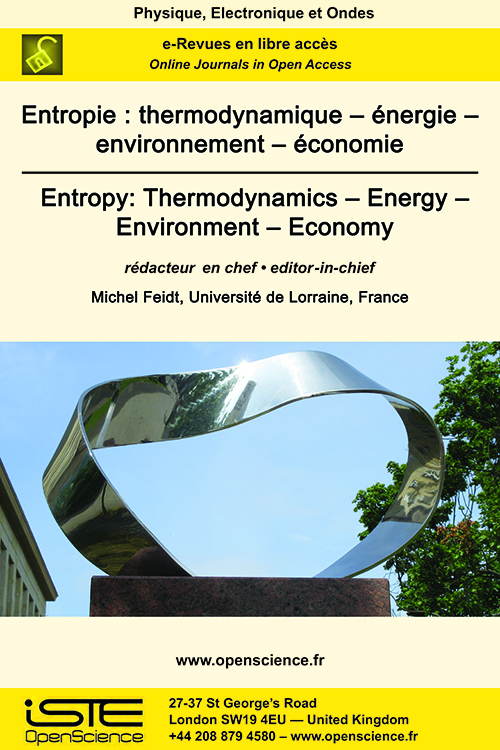

Physics > Home > Entropy: Thermodynamics – Energy – Environment – Economy > Issue
Efficiency of turbomachinery is usually defined using an isentropic process. This approach provides a reliable reference point only when pressure and temperature measurements are available, e.g. at the casing inlet and outlet. In the case of a single stage internal efficiency determination the reference point is difficult. Computational fluid dynamics allows for an exact calculation of values of losses occurring in a turbine stage from turbine blades geometry, clearances, uneven steam distribution and other. Present method is a three-dimensional polytrophic approach based on work comparison of a turbine stage using real and ideal working fluid. The reference state is estimated by iterative simulation of considered geometry using the Eulerian model of compressible fluid. This approach is more convenient and feels natural when using 3D modeling. Moreover, calculations conducted for a control stage indicated differences between results attained using those two approaches less than 0.2%.
Reducing greenhouse gas emissions is an urgent matter and rethinking the world’s vehicle fleet must be done with the utmost care because there will not be a second chance. All-electric vehicles, the attractiveness of the "new mobility" formula and proposals for new uses are obvious. Electric vehicles have the merit of helping to reduce pollution in our cities. However, they cannot be considered zero-emission vehicles. As for the thermal vehicle, it has certainly not exhausted its margins for improvement. It should see its energy efficiency almost double by 2035 while reducing CO2 and pollutant emissions. This paper presents a global reflection on the possible strategies to adopt.
In order to comply with the future emissions regulations, at this point, it seemed that more and more automotive manufacturers will use the Miller over-expanded cycle. In our past research, we highlighted the fact that the implementation of the Miller cycle comes with a drawback related to the decreasing of the intensity of the internal aerodynamics. This paper aims to highlight the impact of some constructive modifications done in order to improve the turbulence level inside the cylinder while operating in Miller cycle. More precisely, it is about the increasing of the piston stroke and the introduction of the masking at the intake valve level. The effect of these modifications is assessed through 3D CFD simulation based on the RANS approach.
Experimental measurements by thermocouples and infrared thermography are made in the intercooler of a supercharged spark-ignition engine (engine displacement: 1.2L, compression ratio: 10.5:1, power: 95.6kW) for several engine operating points. A calculation method is developed to define locally the fluid thermal properties (density, specific heat, dynamic viscosity, etc, …) as a function of temperature. Following, local heat transfer coefficient and Nusselt number are determined.
New environmental regulations are encouraging automakers to focus on over-expanded cycles and to set aside the classic Otto cycle. The Miller cycle is part of this family of cycles and can be applied to spark ignition engines easily by modifying the intake valve closing event. The engine expands more than the actual compression phase. The millerization of an engine is done by increasing the size of the engine and closing the intake valves in advance. The closing time is chosen to follow the same effective compression phase as the reference engine. This process is known as "rightsizing". This paper describes a zero-dimensional approach to estimate the benefits obtained by millerization of a reference engine. The model includes a heat transfer sub-model, based on the Woschni coefficient, as well as a friction sub-model that allows us to take into account the effect of an increase in size. Premature closure of the intake valves in the Miller cycle tends to reduce the intensity of aerodynamic movements within the cylinder, so the level of turbulence at the end of compression is reduced. This phenomenon increases combustion duration and affects efficiency. A K-k-ε turbulence model is used to estimate the intensity of turbulence at the end of compression. A relationship between combustion time and turbulence is proposed. For the reference engine, the benefits obtained by millerisation allow an increase of one efficiency point, corresponding to an efficiency improvement of about 3%.

2025
Volume 25- 6
Issue 12024
Volume 24- 5
Special issue LILA 22023
Volume 23- 4
Issue 12022
Volume 22- 3
Issue 12021
Volume 21- 2
Special issue2020
Volume 20- 1
Issue 1